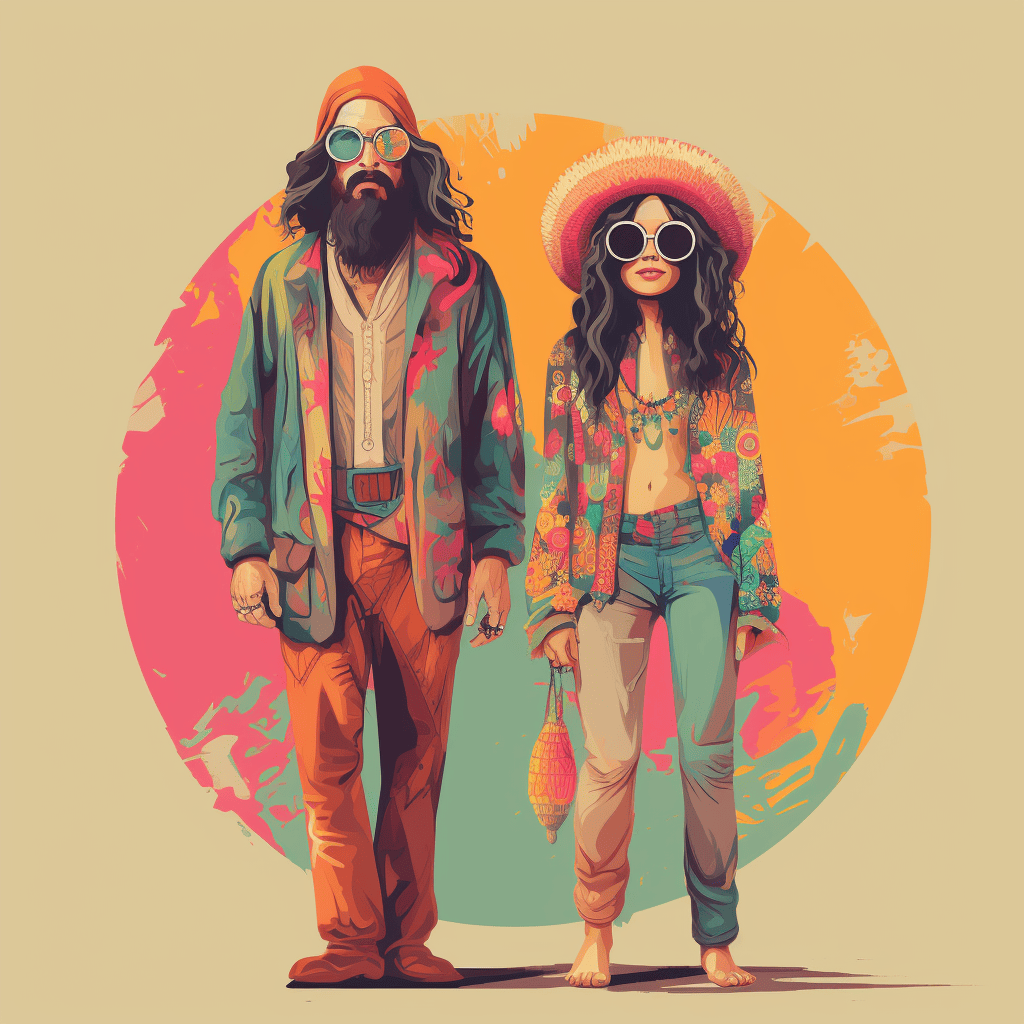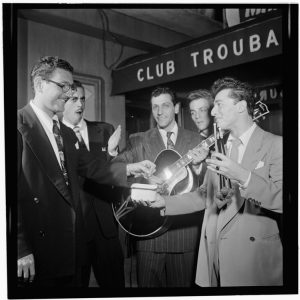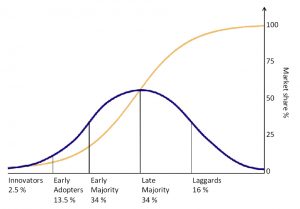47+ Subculture Examples (Definition + Theories)

In the grand tapestry of human society, we often find comfort in belonging to a larger group. We may identify with our nationality, religious beliefs, or social class, among other things.
But have you ever felt like you also belong to a smaller, more specific group that shares your unique interests, values, or activities? That's where the fascinating world of subcultures comes into play.
A subculture is a group of people within a larger culture who share interests, beliefs, or activities that are different from those of the larger culture.
Think of it like a smaller group inside a big group. These subcultures can be based on anything from music and fashion to sports or religion. They have their own rules, lingo, and ways of doing things, but they're still part of the bigger culture they come from.

Ever wondered how punk rockers and goths differ, even though they both seem to love the color black? Or how digital nomads manage to work from the most exotic locations around the globe?
Buckle up, as we're about to dive deep into these captivating worlds. From the iconic to the obscure, from the United States to South Korea, we've got it all covered. Along the way, we'll also delve into theories that help explain why these subcultures exist and what they mean to their members.

The Importance of Subcultures

You might wonder, "Why should we care about subcultures?" Well, subcultures are more than just groups of people who like the same things. They play a big role in shaping who we are, how we see the world, and even how society changes over time. Let's break down some of the main reasons subcultures are important.
A Place to Belong: Feeling like you belong somewhere is super important for everyone, no matter how old you are. Subcultures give people a special place where they can fit in. For example, the "hippie" subculture of the 1960s in America gave people who questioned things like war and traditional social rules a place to belong.
Showcasing Creativity: Subcultures are often full of creative energy. Take the "Harajuku" style in Japan, which became famous around the late 1990s. In this subculture, people wear colorful, wild outfits that you won't see anywhere else. This creativity can even influence mainstream fashion and art.
Challenging the Status Quo: Some subcultures shake things up and make people think differently about big issues. The "punk" subculture that started in the late 1970s in places like the United Kingdom and the United States did just that. They used music and fashion to speak out against things they didn't agree with, like certain government actions or social issues.
Spreading New Ideas: Subcultures can be like testing grounds for new ideas. The "Silicon Valley" tech culture is a great example. Starting around the 1970s in California, USA, this group of tech-savvy folks have come up with inventions that changed the whole world, like smartphones and social media.
Connecting People Across the Globe: Thanks to the internet, some subcultures connect people from all over the world. Take "K-pop" fans as an example. What started as a music genre in South Korea has now spread worldwide. Fans from different countries can share their love for K-pop through social media, even if they've never met in person.
Preserving Traditions: Some subcultures help keep old traditions alive. In Native American communities, there are subcultures focused on preserving traditional practices and languages . This is super important for keeping their history and culture going strong.
Making Us Think: Finally, subcultures make us question what we know. They show us that there's not just one right way to live or think. They help us be more open-minded.
How Subcultures Form
Ever wondered how these cool or quirky groups called "subcultures" come to be? It's not like they pop up overnight. There are some key ingredients that help these special communities form. Let's dive into how subcultures take shape.
Shared Interests or Beliefs: The first step in forming a subculture usually comes from people having something in common. Maybe it's a type of music they all love, or maybe it's a cause they care deeply about. For example, the environmentalist subculture started to really grow in the 1970s in the United States when more people became worried about pollution and saving our planet.
A Feeling of Being Different: Sometimes people feel they're not quite like everyone else around them. This feeling can lead them to seek out others who are similar. That's how the "Goth" subculture started in the United Kingdom in the early 1980s. People who didn't fit into mainstream culture found a new place where they felt at home.
Need for Support: In some cases, subcultures form because people need emotional or even physical support. Think about the LGBTQ+ community, which has many subcultures within it. These spaces offer support and a sense of family for those who might not find it elsewhere.
A Spark or Trigger: Sometimes a big event or a new invention can act like a spark that lights up a subculture. The "Hacker" subculture became more known after the invention of the personal computer and the internet. Suddenly, people could explore a whole new digital world, and those interested in it became part of this subculture.
Leaders and Influencers: Often, strong leaders or influencers help to build and shape subcultures. Martin Luther King Jr. played a crucial role in the Civil Rights Movement, which had its own unique subculture focused on racial equality in America during the 1950s and 1960s.
Places and Spaces: The right place can also be a big factor. Take the "surfer" subculture in places like California, USA, and Australia. The beaches became the perfect spots for this community to grow and live out their passion.
Time and Evolution: Subcultures don't stay the same forever. They can change, mix with other groups, or even fade away. Remember the "disco" craze in the 1970s? It was a huge thing back then but has evolved and mixed with other music styles over time.
Subculture Theories
Each of these theories offers unique perspectives on why subcultures form and what roles they play in society. Understanding them can help us appreciate the richness and complexity of the subcultures we'll explore in this guide.
1) Strain Theory
Creator and origin.
The Strain Theory was primarily developed by American sociologist Robert K. Merton in the early 20th century, specifically in the 1930s and 1940s. Merton was working in the United States when he came up with this theory.
Main Points
Strain Theory suggests that society sets certain cultural goals and social expectations for its members. When individuals or groups are unable to achieve these goals through socially accepted means, they may experience strain or stress.
This emotional strain leads them to form or join subcultures where they can find an alternative set of norms and values that make them feel accepted and validated.
For instance, if society values financial success but not everyone has the opportunity to achieve it, those who can't may join subcultures that value other aspects of life, such as artistry or social activism.
Counter-Arguments
One of the criticisms of Strain Theory is that it might overly simplify human behavior by attributing subculture formation primarily to 'strain.' Critics argue that this ignores other complex factors, including personal choice and historical context.
Additionally, the theory is often critiqued for its focus on deviance and social discord, which may not be a prevalent characteristic in all subcultures.
2) Subcultural Theory
The Subcultural Theory has its roots in the Chicago School of sociology, particularly the work of researchers like Ernest Burgess and Robert E. Park in the early-to-mid 20th century. However, the theory gained significant attention through British sociologists like Albert Cohen and the Birmingham School in the 1970s.
Subcultural Theory claims that subcultures have their own set of norms, values, and practices that may differ significantly from the dominant culture.
The theory often emphasizes style, language, and rituals as ways in which subcultures express their differences. For example, the goth subculture has its own style of clothing (black), language (for instance, "baby bat" is what they call new members), and music that distinguishes it from mainstream culture (for instance, the band Bauhaus ).
A common criticism of Subcultural Theory is its tendency to stereotype or categorize individuals based on their belonging to a particular group. This can lead to oversimplification and may not account for individuals who belong to multiple or overlapping subcultures.
3) Post-subcultural Theory
Post-subcultural Theory emerged in the late 20th and early 21st centuries, primarily in academic circles . It is a critique and extension of traditional subcultural theories, and there is no single person credited with its formation.
The theory argues that the landscape of subcultures is ever-changing, influenced by things like globalization and digital technology.
It recognizes that individuals may participate in multiple subcultures simultaneously and that subcultures themselves can have sub-subcultures.
For instance, the online gaming community could be considered a post-subcultural group, as it includes various gaming genres and international players.
Critics say that Post-subcultural Theory might be too loose in its definitions, making it difficult to study or understand subcultures in a systematic way.
The very fluidity and adaptability the theory celebrates could make it challenging to establish boundaries or characteristics for a given subculture.
4) Resistance Theory
Resistance Theory came from multiple sources but is strongly linked to the works of cultural studies academics like Dick Hebdige and Stuart Hall, especially from the 1970s onward, working primarily in the United Kingdom.
Resistance Theory posits that subcultures offer a form of resistance or opposition to dominant cultural norms or political systems. They act as a space where members can challenge and critique societal expectations.
The punk subculture, for example, was initially a form of resistance against the political and social climates of the 1970s .
One of the main criticisms of Resistance Theory is that not all subcultures are about fighting the system. Some may simply be an expression of preference or lifestyle without any intention to challenge societal norms .
Subculture Examples
The hippie subculture emerged during the early 1960s in the United States, particularly around the San Francisco Bay Area. It gained fame for its opposition to the Vietnam War and its promotion of peace and love.
Influential people like Janis Joplin and Jimi Hendrix became icons, with the Woodstock Music Festival in 1969 serving as a pivotal moment for the movement.
Hippies were known for their laid-back lifestyle, embracing nature, and experimenting with new forms of spirituality. Many were vegetarians or vegans and preferred organic foods. Dressing in colorful, flowy clothing and wearing accessories like peace signs and flowers were common. They also enjoyed psychedelic, folk, and rock music.
The movement had its own media outlets like the “Whole Earth Catalog” that showcased their love for nature and DIY practices.
The goth subculture sprouted in the United Kingdom around the early 1980s, tied closely to the gothic rock scene.
Well-known bands in this subculture include Bauhaus and The Cure. The movie "The Crow" has also been a cult classic among Goths.
Members of this subculture are easily identified by their dark, mysterious, and complex aesthetic, often wearing predominantly black clothing, dark makeup, and sporting unusual hairstyles.
They have a penchant for literature and art that explores themes of existential despair, depression, and other deep emotional states. Some also engage in crafting, like making their own jewelry or clothing.

Originating in Japan in the 1980s, the Otaku subculture is focused around a deep love for anime and manga.
Popular series like "Naruto" and "Dragon Ball" are staples, and Hayao Miyazaki, co-founder of Studio Ghibli, is a significant figure in the community.
Otakus often collect action figures, posters, and other memorabilia of their favorite series or characters. Many also participate in cosplay, dressing up as their favorite characters during conventions.
Online forums and fan websites serve as their communal space where they discuss new releases, plot theories, and share fan-made content like art and stories.
The hip-hop subculture originated in the late 1970s within African American and Latino communities in the Bronx, New York City.
Icons in this subculture range from early figures like Grandmaster Flash to modern-day moguls like Jay-Z. Movies such as "8 Mile" starring Eminem have also popularized the culture.
More than just a musical genre, hip-hop encompasses various art forms including breakdancing and graffiti art. The subculture often tackles themes of identity, social issues, and the struggles and triumphs of life in the inner city. Fashion is also a major component, with styles ranging from baggy pants and oversized shirts to designer labels.
Skateboarding culture took off in California, USA, in the late 1950s and 1960s as an extension of surf culture.
Famous figures like Tony Hawk have brought mainstream attention to skateboarding, and movies such as "Lords of Dogtown" portray its history.
Skaters are dedicated to the art and sport of skateboarding, spending hours at skate parks or other urban areas practicing tricks. The fashion is practical yet distinctive, usually featuring durable and casual clothes like t-shirts, jeans, and skate shoes.
In addition to physical skating, the culture includes its own style of art, photography, and even language, with specific terms for tricks and skateboard components.
6. Punk Rockers
The punk subculture originated in the mid-1970s in the United States and the United Kingdom. It was more than just a music genre—it was a rebellion against mainstream society and its norms.
Iconic bands like The Sex Pistols and The Ramones served as the soundtrack for this movement.
In terms of fashion, punk rockers often wore ripped jeans, leather jackets, and had colorful mohawks or spiked hair. Some would create their own clothes using safety pins and patches.
The ethos of the punk movement was about challenging authority, embracing DIY ethics, and promoting individual freedom. Zines (short for "magazines") were a popular way punks spread their messages, and venues like CBGB in New York City became sacred spaces for them.
7. Beatniks
The Beatniks were a subculture that took shape in the 1950s in America, closely linked to the Beat Generation writers like Jack Kerouac and Allen Ginsberg.
This group was known for its bohemian lifestyle and disdain for conventional society and materialism. They often gathered in coffeehouses and jazz clubs, discussing literature, philosophy, and social issues.
Dressing simply, often in black turtlenecks and berets, their minimalist style was a statement against consumer culture. They were also known for their unique spoken-word performances and experimental writing styles.
Rave culture started in the late 1980s in the United Kingdom, particularly linked to electronic dance music (EDM).
DJs like Paul Oakenfold and events like the Second Summer of Love in 1988-1989 are often cited as pivotal points in this subculture.
Ravers are known for their colorful, often extravagant outfits, covered in beads, glow sticks, and sometimes even stuffed animals.
The scene is heavily influenced by a sense of community and unity, often symbolized by the phrase PLUR (Peace, Love, Unity, Respect). Large rave events and music festivals are the main social gatherings, and some members are involved in creating light shows or dance routines.
9. K-pop Fans
Originating in South Korea but now a global phenomenon, the K-pop fan subculture is a dedicated community that revolves around Korean pop music.
Artists like BTS and BLACKPINK are some of the most well-known figures. Fans engage in activities like streaming music videos to break records, creating fan art, and even learning Korean to better understand the songs and shows.
Fashion is also an essential aspect, with many fans emulating the unique and often gender-fluid styles of their favorite idols.
10. Environmentalists
The environmentalist subculture really started to grow in the 1970s in the United States and spread globally.
Notable figures include Rachel Carson, author of "Silent Spring," which helped kickstart the modern environmental movement.
These individuals are passionately concerned about issues like climate change, conservation, and sustainable living.
Practices include recycling, composting, and engaging in activism to protect natural resources. They often read or produce literature and documentaries that focus on environmental issues, and some even adopt minimalist lifestyles to reduce waste.
11. Trekkies

Trekkies, or Trekker if you prefer, are fans of the science fiction series "Star Trek," which originally aired in the 1960s in the United States.
Icons of this subculture include Leonard Nimoy, who played Spock, and Gene Roddenberry, the creator of the series.
Trekkies are known for attending Star Trek conventions dressed as their favorite characters and engaging in deep discussions about the philosophical and ethical questions posed by the series. This subculture spans various generations and has inspired a rich trove of fan fiction, art, and even technical manuals for fictional starships.
12. Bronies
Bronies are adult fans of the animated TV show "My Little Pony: Friendship is Magic," which was intended for young children, particularly girls. Originating in the United States in the 2010s, this subculture took many by surprise.
While the show is the main focus, many bronies also engage in creating fan art, fan fiction, and music based on the series. They often meet at specialized Brony conventions, and some even engage in cosplay.
13. Juggalos
The Juggalos are fans of the band Insane Clown Posse, which originated in Detroit, Michigan, USA, in the 1990s. They're known for their passionate support of the band and their love for Faygo, a brand of soda. They wear face paint similar to that of the band members and have their own slang and hand signs.
The annual Gathering of the Juggalos serves as their main social event. Although often misunderstood, the Juggalos consider themselves a tight-knit community, bound together by their love for the band's music, which often deals with themes of poverty and class struggle.
14. Cybergoths
Cybergoths emerged in the late 1990s as a derivative of the traditional goth community. They blend elements of industrial music, rave culture, and goth aesthetics.
Originating in the United Kingdom, they are often spotted in neon dreadlocks, futuristic attire, and sometimes even wear gas masks. While they share the goth community's love for dark themes, they diverge in terms of fashion and music, often embracing electronic and industrial tunes.
15. Sneakerheads
Sneakerheads are individuals who are enthusiastic about collecting, trading, or admiring sneakers.
This subculture started growing in the United States in the late 1980s, especially with the release of Air Jordans. They follow sneaker release dates religiously and are willing to camp out in front of stores for limited editions.
Celebrities like Kanye West have even entered the space, designing their own line of sneakers. Websites, blogs, and forums act as gathering spaces where sneakerheads discuss upcoming releases, trends, and even the technology of sneakers.
16. Steampunk
Originating in the late 1980s, Steampunk is a subgenre of science fiction that incorporates technology and aesthetic designs inspired by 19th-century industrial steam-powered machinery.
This subculture gained popularity in the United States and United Kingdom and is often seen in literature, fashion, and even some DIY crafts. People in this subculture often dress in Victorian-era clothing but add modern, technological twists. Think goggles, gears, and airships! Events like the "Steampunk World's Fair" serve as gathering points.
17. Rockabilly
Rockabilly is both a musical genre and a subculture, inspired by 1950s rock and roll, most notably by artists like Elvis Presley and Johnny Cash.
Originating in the United States, Rockabilly culture also incorporates vintage fashion, usually from the 1940s and 1950s. Think high-waist skirts for women and grease-styled hair for men. Classic cars and pin-up art are also much admired within this community.
18. Body Modification Enthusiasts
This subculture is focused on altering the human body, often through tattoos, piercings, and sometimes more extreme measures like subdermal implants.
Though practices like tattooing have ancient origins, the modern subculture took shape in Western countries from the mid-20th century. Events like tattoo conventions serve as major gathering points, and magazines like "Inked" are popular reading material.
19. Metalheads
Fans of heavy metal music, commonly known as Metalheads, form a subculture that originated in the late 1960s and early 1970s in the United Kingdom and the United States with bands like Black Sabbath and Led Zeppelin.
Metalheads are known for their distinctive look, often featuring long hair, black clothing, leather jackets, and band t-shirts. Concerts, or "gigs," serve as their primary social setting, and they often engage in headbanging as a form of dance.
20. Preppers

Also known as survivalists, Preppers are individuals who actively prepare for emergencies, ranging from natural disasters to apocalyptic scenarios.
Originating mainly in the United States, this subculture has grown especially with the rise of the internet, where information on survival tactics is readily shared. Preppers stockpile food, learn survivalist techniques, and often live by the motto "be prepared."
21. The Furry Fandom
Originating in the early 1980s in the United States, the Furry Fandom is a subculture interested in anthropomorphic animals—animals with human characteristics.
This community expresses itself through art, writing, and especially through "fursuiting," which is wearing full-body animal costumes. Events like Anthrocon serve as major social gatherings where furries can meet and share their passion.
22. The Maker Movement
Starting in the early 2000s in the United States, the Maker Movement celebrates DIY (Do-It-Yourself) crafting and technology.
This subculture loves to build things from the ground up, from simple crafts to complicated robots. Maker Faires are events where these DIYers can display their creations and share their knowledge.
23. Psychobilly
This unique blend of rockabilly and punk rock originated mainly in the UK in the late 1970s and early 1980s.
Psychobilly fans often wear a unique style that could include mohawks, tattoos, and vintage clothes. The music has a fast tempo and lyrics often inspired by horror themes.
24. Straight Edge
Born out of the hardcore punk community in the early 1980s in Washington, D.C., USA, the Straight Edge subculture focuses on abstaining from alcohol, tobacco, and recreational drugs.
Some also avoid casual dating or eating animal products. Bands like Minor Threat played a big role in shaping this movement. The "X" symbol is often used to mark this lifestyle.
25. CrossFit Community
CrossFit is a fitness regimen that gained popularity in the early 2000s in the United States. However, it quickly evolved into a subculture complete with its own jargon, social norms, and events like the CrossFit Games.
Members often forge a strong sense of community, supporting each other's fitness goals while adhering to a lifestyle that prioritizes health and strength.
The Vaping subculture emerged around 2010 as an alternative to traditional smoking, primarily in the United States.
Vapers are people who use e-cigarettes or other vaporizing devices. They often meet at vaping lounges to try out different flavors and discuss the technology behind vaping.
While critics argue about the health effects, vapers often see themselves as part of a healthier and trendier alternative to smoking.
27. Audiophiles
Audiophiles are enthusiasts of high-quality audio and have been around since the mid-20th century. Originating primarily in the United States and Europe, this subculture is dedicated to achieving the best sound quality possible in listening to music.
Members are often willing to invest in high-end equipment and will even debate over minute details like the quality of audio cables. Specialized audio shows serve as their primary social gatherings.
28. Cosplayers
Cosplay, short for "costume play," is a subculture where people dress up as characters from movies, books, or video games. It has roots in Japan but has become a global phenomenon.
Popular events include Comic-Con and various anime expos. The attention to detail in the costumes can be astounding, with some people spending months crafting their outfits.
29. Hikers and Mountaineers
The hiking and mountaineering subculture dates back to at least the 19th century and originated in Europe.
With famous figures like Sir Edmund Hillary, who was one of the first two men to reach Mount Everest's summit, this subculture is all about conquering natural obstacles. Members often engage in training, invest in specialized gear, and form clubs to undertake expeditions.
30. Van Life Community

Originating in the 1960s with the popularization of the Volkswagen Bus, the Van Life community has seen a resurgence in the 2010s, particularly in the United States.
People in this subculture choose to live, travel, and sometimes work out of their vans. Social media platforms, especially Instagram, are commonly used to share experiences and tips within this community.
31. Krumpers
Krumping is a street dance that originated in the African American communities of Los Angeles, USA, in the early 2000s.
This energetic dance form is a way for people to express their emotions and is often used as a form of spiritual and emotional release. Krumpers frequently participate in "battles" which are competitive but non-violent confrontations with other dancers.
32. Graffiti Artists
Graffiti as an art form has been around for centuries, but the modern graffiti subculture began in the 20th century in New York City.
It involves creating art in public spaces, usually without permission. While many people see graffiti as vandalism, others view it as a legitimate form of art and expression. Names like Banksy have even moved graffiti into mainstream art galleries.
33. Urban Explorers
Also known as "urbex," this subculture involves exploring man-made structures, usually abandoned ruins or places not usually seen by the public.
Originating in the late 20th century in North America and Europe, "urbexers" often document their explorations in photographs or videos. However, this practice is risky and often illegal, raising concerns about trespassing and safety.
34. Surfers
The modern surfing subculture originated in the early 20th century in Hawaii and California. Surfers are not just passionate about riding waves; they often embrace a laid-back lifestyle connected to the sea.
Events like the World Surf League offer professional surfers a platform, while films like "Endless Summer" have popularized the culture.

35. Parrotheads
This unique subculture consists of fans of singer-songwriter Jimmy Buffett and originated in the United States.
Known for their tropical-themed parties and laid-back attitude, Parrotheads are active in community service and often raise money for charity through their events. They take their name from Buffett's song "Margaritaville," where a "parrot" is mentioned.
36. Foodies
The term "Foodie" started getting popular in the 1980s, mainly in the United States and the United Kingdom. Foodies are people who have a strong interest in food, both in its preparation and consumption.
They love trying new culinary experiences, attending food festivals, and are often found taking photos of their meals for social media. Celebrity chefs like Gordon Ramsay and TV shows like "Top Chef" have given this subculture more visibility.
37. E-Gamers
This subculture centers around competitive video gaming and originated in the late 1990s with the popularization of online games.
Originating mainly in South Korea and the United States, e-gamers often compete in large tournaments with massive audiences. Games like League of Legends and Fortnite have massive followings, and professional players can become celebrities in this subculture.
38. Tiny House Movement
Starting in the early 2000s in the United States, the Tiny House Movement is a social and architectural trend advocating living simply in small homes.
Members of this subculture prioritize minimalistic living and often build their own compact houses that are functional but much smaller than the average American home.
39. Witches and Wiccans
Although witchcraft and Wiccan practices have ancient roots, the modern subculture has been growing since the mid-20th century.
It is a religious and spiritual movement that incorporates the worship of the Goddess, nature rites, and often the practice of magic. Books like "The Witch Book" by Raymond Buckland and festivals like Pagan Pride Day contribute to its community aspects.
40. Lolitas
Originating from Japan, Lolita fashion is a subculture that involves wearing clothes inspired by the Victorian and Rococo eras.
This style has various sub-genres, including Gothic Lolita, Sweet Lolita, and Classic Lolita. The outfits often include frilly dresses, bonnets, and parasols. This subculture has worldwide popularity, and its followers participate in meetups and tea parties.
41. Rastafarians
Originating in Jamaica in the 1930s, the Rastafari movement blends religion, social consciousness, and Afrocentric ideology.
Followers, known as Rastafarians or Rastas, often wear dreadlocks and promote a back-to-nature lifestyle. Reggae music, particularly through artists like Bob Marley, has helped popularize this subculture worldwide.
42. Burners
Burners are participants in the Burning Man festival, which began in 1986 in the United States.
This annual event, held in Nevada's Black Rock Desert, brings together a unique mix of art installations, music, and alternative community-building. Self-expression and self-reliance are highly valued in this subculture.
43. Train Spotters
Often originating from the United Kingdom, train spotting is a hobby involving the observation and recording of train details.
Enthusiasts often gather at railway stations with notepads and cameras, documenting train models, schedules, and more. Publications and clubs exist to serve this community.
44. Urban Gardeners

This subculture is focused on cultivating plants in an urban environment and originated in various cities worldwide.
Urban Gardeners often use unconventional spaces like rooftops and balconies for their gardens. The movement aims to promote sustainability and community well-being.
45. Modern Nomads
Modern Nomads are individuals who choose a lifestyle that involves constant or frequent travel, often working remotely to sustain their way of life.
Originating in the digital age, members of this subculture can come from almost anywhere but are most prominent in Western countries.
46. Bike Couriers
Mostly found in large metropolitan cities worldwide, bike couriers, or "messengers," form a subculture centered around delivering packages on bicycles. Known for their skillful riding in busy urban environments, they often have their own slang, fashion, and social norms.
47. Yoga Enthusiasts
While Yoga is a physical and spiritual practice originating from India, a new subculture has emerged globally, particularly in Western countries.
This subculture revolves around the practice of yoga not just as exercise but also as a lifestyle that encompasses diet, mindfulness, and spirituality. Yoga practitioners often gather in yoga studios to practice in group yoga classes, and will often have international "retreats" where "yogis" will go for a week or a month or sometimes even longer to engage in yoga full-time.
Subcultures are like the many threads that make up the vibrant tapestry of human society. They offer people a space to express themselves, find community, and often, make a meaningful impact on the broader culture. From the music enthusiasts of K-Pop and Jazz to the lifestyle-centric folks like Van Lifers and Digital Nomads, each subculture brings a unique flavor to the world we live in.
Understanding subcultures isn't just a way to 'know more'; it's a pathway to better understanding the complexities of human life. Many of these groups form around fundamental human needs—like the need to belong, the need to be understood, or even the need to push conventional boundaries. They can offer solace, identity, and a place to call home—even if that 'home' is a virtual forum on the internet or a yearly gathering in a remote desert.
As society keeps evolving, so will the subcultures that spring from it. New forms of music, changes in politics, advancements in technology, and shifts in social attitudes will inevitably give rise to new subcultures. And as they emerge, they'll offer fresh perspectives that will continue to enrich our collective experience.
So the next time you stumble upon a group of people united by a shared passion or a unique way of life, take a moment to understand what makes them tick. Who knows? You might find a new community where you feel right at home.
Related posts:
- 37+ Social Construct Examples (Definition + Game)
- Art Therapist Career (Salary + Duties + Interviews)
- 5+ High School Stereotypes (Definition + Examples)
- 40+ Famous Psychologists (Images + Biographies)
- Motor Cortex Function
Reference this article:
About The Author

Free Personality Test

Free Memory Test

Free IQ Test

PracticalPie.com is a participant in the Amazon Associates Program. As an Amazon Associate we earn from qualifying purchases.
Follow Us On:
Youtube Facebook Instagram X/Twitter
Psychology Resources
Developmental
Personality
Relationships
Psychologists
Serial Killers
Psychology Tests
Personality Quiz
Memory Test
Depression test
Type A/B Personality Test
© PracticalPsychology. All rights reserved
Privacy Policy | Terms of Use
What are Subcultures?
This essay about subcultures explores the complex interplay of identities, ideologies, and expressions within these distinct cultural groups. It discusses how subcultures, ranging from gothic to punk, serve as communities for shared interests and platforms for creativity and resistance. The piece highlights their role in societal evolution, the challenges of internal conflicts, and the impact on cultural dynamics. Through this analysis, the essay emphasizes the importance of understanding subcultures in appreciating the broader narrative of human culture and societal change.
How it works
Delving into the rich tapestry of subcultures reveals a complex mosaic of identities, ideologies, and expressions that define these fascinating cultural niches. Subcultures, embedded within the broader fabric of society, serve as vibrant ecosystems where individuals with shared passions and beliefs come together, shaping unique collective identities and stories. This exploration seeks to illuminate the distinctive traits, roles, and broader societal impacts of subcultures, highlighting their significant influence on cultural evolution and human interaction.
At the core of subcultures is their ability to draw people into communities based on common interests and convictions. Need a custom essay on the same topic? Give us your paper requirements, choose a writer and we’ll deliver the highest-quality essay! Order now
These subcultural groups often originate from diverse origins, such as musical tastes, fashion trends, political beliefs, or lifestyle choices. The gothic subculture, for example, emerged in the late 20th century as an amalgamation of dark aesthetic, romantic literature, and alternative music, creating a rich, introspective community for its followers.
Subcultures also act as hotbeds of creativity and individual expression, where art, language, and customs converge to craft unique identities and stories. They offer a canvas of symbols, sounds, and styles, where innovation flourishes, enriching the wider cultural sphere with fresh insights and viewpoints. Consider the graffiti subculture, which challenges traditional art forms by converting cityscapes into dynamic expressions of social critique and creative defiance.
In addition to fostering creativity, subcultures provide a voice for the marginalized and a challenge to mainstream cultural dominance. They offer a sanctuary for those seeking solidarity in facing societal challenges, creating a sense of community among those who feel disenfranchised. The punk movement is a prime example of this, promoting an ethos of self-sufficiency and political engagement, sparking widespread influence and ongoing dialogue about social change.
However, despite their appearance of unity, subcultures are not without internal complexities and conflicts. They can be marked by divisions and disagreements over the true essence of their identity and values, reflecting a broader spectrum of human interaction and cultural diversity. These dynamics highlight the inherent complexity and continuous evolution within subcultures, inviting ongoing debate and engagement.
Ultimately, subcultures are dynamic and multifaceted, embodying a spectrum of human experiences and ideologies. They are defined by commonalities in aesthetics and values, fostering environments rich in creativity, resistance, and community bonding. Despite their cohesive fronts, the underlying tensions and disagreements within subcultures remind us of the perpetual motion and complexity of cultural identity. By studying subcultures, we deepen our understanding of the broader human narrative, where individual and collective stories are interwoven into the ongoing dialogue of cultural transformation and societal development.
Cite this page
What are Subcultures?. (2024, Apr 22). Retrieved from https://papersowl.com/examples/what-are-subcultures/
"What are Subcultures?." PapersOwl.com , 22 Apr 2024, https://papersowl.com/examples/what-are-subcultures/
PapersOwl.com. (2024). What are Subcultures? . [Online]. Available at: https://papersowl.com/examples/what-are-subcultures/ [Accessed: 18 Nov. 2024]
"What are Subcultures?." PapersOwl.com, Apr 22, 2024. Accessed November 18, 2024. https://papersowl.com/examples/what-are-subcultures/
"What are Subcultures?," PapersOwl.com , 22-Apr-2024. [Online]. Available: https://papersowl.com/examples/what-are-subcultures/. [Accessed: 18-Nov-2024]
PapersOwl.com. (2024). What are Subcultures? . [Online]. Available at: https://papersowl.com/examples/what-are-subcultures/ [Accessed: 18-Nov-2024]
Don't let plagiarism ruin your grade
Hire a writer to get a unique paper crafted to your needs.

Our writers will help you fix any mistakes and get an A+!
Please check your inbox.
You can order an original essay written according to your instructions.
Trusted by over 1 million students worldwide
1. Tell Us Your Requirements
2. Pick your perfect writer
3. Get Your Paper and Pay
Hi! I'm Amy, your personal assistant!
Don't know where to start? Give me your paper requirements and I connect you to an academic expert.
short deadlines
100% Plagiarism-Free
Certified writers
Open Education Sociology Dictionary
Table of Contents
Definition of Subculture
( noun ) A group within society whose behaviors , norms , and values differ in some distinct ways from the dominant culture.
Example of Subculture
- The Trekker (also called Trekkie ) subculture has its own mode of dress (e.g., original series, Next Generation) beliefs (e.g., the Prime Directive), language (e.g., Klingon), and folklore (e.g ., the individual wearing a red shirt will not return from an away mission).
Subculture Pronunciation
Pronunciation Usage Guide
Syllabification : sub·cul·ture
Audio Pronunciation
Phonetic Spelling
- American English – /sUHb-kuhl-chuhr/
- British English – /sUHb-kuhl-chuh/
International Phonetic Alphabet
- American English – /ˈsəbˌkəltʃər/
- British English – /ˈsʌbˌkʌltʃə/
Usage Notes
- Plural: subcultures
- A type of culture .
- Type: counterculture
- Variant spelling: sub-culture
Related Video
Additional Information
- Word origin of “subculture” – Online Etymology Dictionary: etymonline.com
Related Terms
- dependency culture
- explicit culture
- high culture
- low culture
- mass culture
- nonmaterial culture
- popular culture
Works Consulted
Andersen, Margaret L., and Howard Francis Taylor. 2011. Sociology: The Essentials . 6th ed. Belmont, CA: Wadsworth.
Bilton, Tony, Kevin Bonnett, Pip Jones, David Skinner, Michelle Stanworth, and Andrew Webster. 1996. Introductory Sociology . 3rd ed. London: Macmillan.
Brinkerhoff, David, Lynn White, Suzanne Ortega, and Rose Weitz. 2011. Essentials of Sociology . 8th ed. Belmont, CA: Wadsworth.
Brym, Robert J., and John Lie. 2007. Sociology: Your Compass for a New World . 3rd ed. Belmont, CA: Wadsworth.
Carrabine, Eamonn, Pam Cox, Maggy Lee, Ken Plummer, and Nigel South. 2009. Criminology: A Sociological Introduction . 2nd ed. London: Routledge.
Clarke, Alan. 2010. The Sociology of Healthcare . 2nd ed. Harlow, England: Longman.
Clinard, Marshall Barron, and Robert Frank Meier. 2011. Sociology of Deviant Behavior . 14th ed. Belmont, CA: Wadsworth.
Delaney, Tim, and Tim Madigan. 2015. The Sociology of Sports: An Introduction . 2nd ed. Jefferson, NC: McFarland.
Encyclopædia Britannica. (N.d.) Britannica Digital Learning . ( https://britannicalearn.com/ ).
Ferrante, Joan. 2011a. Seeing Sociology: An Introduction . Belmont, CA: Wadsworth.
Ferrante, Joan. 2011b. Sociology: A Global Perspective . 7th ed. Belmont, CA: Wadsworth.
Ferris, Kerry, and Jill Stein. 2010. The Real World: An Introduction to Sociology . 2nd ed. New York: Norton.
Griffiths, Heather, Nathan Keirns, Eric Strayer, Susan Cody-Rydzewski, Gail Scaramuzzo, Tommy Sadler, Sally Vyain, Jeff Bry, Faye Jones. 2016. Introduction to Sociology 2e . Houston, TX: OpenStax.
Henslin, James M. 2012. Sociology: A Down-to-Earth Approach . 10th ed. Boston: Allyn & Bacon.
Hughes, Michael, and Carolyn J. Kroehler. 2011. Sociology: The Core . 10th ed. New York: McGraw-Hill.
Kendall, Diana. 2011. Sociology in Our Times . 8th ed. Belmont, CA: Wadsworth.
Kimmel, Michael S., and Amy Aronson. 2012. Sociology Now . Boston: Allyn & Bacon.
Kornblum, William. 2008. Sociology in a Changing World . 8th ed. Belmont, CA: Wadsworth.
Macionis, John. 2012. Sociology . 14th ed. Boston: Pearson.
Macionis, John, and Kenneth Plummer. 2012. Sociology: A Global Introduction . 4th ed. Harlow, England: Pearson Education.
Macmillan. (N.d.) Macmillan Dictionary . ( https://www.macmillandictionary.com/ ).
Marsh, Ian, and Mike Keating, eds. 2006. Sociology: Making Sense of Society . 3rd ed. Harlow, England: Pearson Education.
Merriam-Webster. (N.d.) Merriam-Webster Dictionary . ( http://www.merriam-webster.com/ ).
Oxford University Press. (N.d.) Oxford Dictionaries . ( https://www.oxforddictionaries.com/ ).
Ravelli, Bruce, and Michelle Webber. 2016. Exploring Sociology: A Canadian Perspective . 3rd ed. Toronto: Pearson.
Schaefer, Richard. 2013. Sociology: A Brief Introduction . 10th ed. New York: McGraw-Hill.
Scott, John, and Gordon Marshall. 2005. A Dictionary of Sociology . New York: Oxford University Press.
Shepard, Jon M. 2010. Sociology . 11th ed. Belmont, CA: Wadsworth.
Shepard, Jon M., and Robert W. Greene. 2003. Sociology and You . New York: Glencoe.
Stolley, Kathy S. 2005. The Basics of Sociology . Westport, CT: Greenwood Press.
Taylor & Francis. (N.d.) Routledge Handbooks Online . ( https://www.routledgehandbooks.com/ ).
Thompson, William E., and Joseph V. Hickey. 2012. Society in Focus: An Introduction to Sociology . 7th ed. Boston: Allyn & Bacon.
Thorpe, Christopher, Chris Yuill, Mitchell Hobbs, Sarah Tomley, and Marcus Weeks. 2015. The Sociology Book: Big Ideas Simply Explained . London: Dorling Kindersley.
Tischler, Henry L. 2011. Introduction to Sociology . 10th ed. Belmont, CA: Wadsworth.
Turner, Bryan S., ed. 2006. The Cambridge Dictionary of Sociology . Cambridge: Cambridge University Press.
Wikipedia contributors. (N.d.) Wikipedia, The Free Encyclopedia . Wikimedia Foundation. ( https://en.wikipedia.org/ ).
Wikipedia contributors. (N.d.) Wiktionary, The Free Dictionary . Wikimedia Foundation. ( http://en.wiktionary.org ).
Wiley. (N.d.) Wiley Online Library . ( http://onlinelibrary.wiley.com/ ).
Cite the Definition of Subculture
ASA – American Sociological Association (5th edition)
Bell, Kenton, ed. 2013. “subculture.” In Open Education Sociology Dictionary . Retrieved November 19, 2024 ( https://sociologydictionary.org/subculture/ ).
APA – American Psychological Association (6th edition)
subculture. (2013). In K. Bell (Ed.), Open education sociology dictionary . Retrieved from https://sociologydictionary.org/subculture/
Chicago/Turabian: Author-Date – Chicago Manual of Style (16th edition)
Bell, Kenton, ed. 2013. “subculture.” In Open Education Sociology Dictionary . Accessed November 19, 2024. https://sociologydictionary.org/subculture/ .
MLA – Modern Language Association (7th edition)
“subculture.” Open Education Sociology Dictionary . Ed. Kenton Bell. 2013. Web. 19 Nov. 2024. < https://sociologydictionary.org/subculture/ >.

Want to create or adapt books like this? Learn more about how Pressbooks supports open publishing practices.
Pop Culture, Subculture, and Cultural Change
- Discuss the roles of both high culture and pop culture within society
- Differentiate between subculture and counterculture
- Explain the role of innovation, invention, and discovery in culture
It may seem obvious that there are a multitude of cultural differences between societies in the world. After all, we can easily see that people vary from one society to the next. It’s natural that a young woman from rural Kenya would have a very different view of the world from an elderly man in Mumbai—one of the most populated cities in the world. Additionally, each culture has its own internal variations. Sometimes the differences between cultures are not nearly as large as the differences inside cultures.
Popular Culture
The term popular culture refers to the pattern of cultural experiences and attitudes that exist in mainstream society. Popular culture events might include a parade, a baseball game, or the season finale of a television show. Rock and pop music—“pop” is short for “popular”—are part of popular culture. Popular culture is often expressed and spread via commercial media such as radio, television, movies, the music industry, publishers, and corporate-run websites. Unlike high culture , reserved for the elite, popular culture is known and accessible to most people. You can share a discussion of favorite football teams with a new coworker or comment on American Idol when making small talk in line at the grocery store. But if you tried to launch into a deep discussion on the classical Greek play Antigone at a subway station, few members of U.S. society today would be familiar with it.
Subculture and Counterculture
A subculture is just what it sounds like—a smaller cultural group within a larger culture; people of a subculture are part of the larger culture but also share a specific identity within a smaller group.
Thousands of subcultures exist within the United States. Ethnic and racial groups share the language, food, and customs of their heritage. Other subcultures are united by shared experiences. Biker culture revolves around a dedication to motorcycles. Some subcultures are formed by members who possess traits or preferences that differ from the majority of a society’s population. The body modification community embraces aesthetic additions to the human body, such as tattoos, piercings, and certain forms of plastic surgery. In the United States, adolescents often form subcultures to develop a shared youth identity. Alcoholics Anonymous offers support to those suffering from alcoholism. But even as members of a subculture band together, they still identify with and participate in the larger society.
Sociologists distinguish subcultures from countercultures , which are a type of subculture that reject some of the larger culture’s norms and values. In contrast to subcultures, which operate relatively smoothly within the larger society, countercultures might actively defy larger society by developing their own set of rules and norms to live by, sometimes even creating communities that operate outside of greater society.
Cults, a word derived from culture, are also considered counterculture group. The group “Yearning for Zion” (YFZ) in Eldorado, Texas, existed outside the mainstream and the limelight, until its leader was accused of statutory rape and underage marriage. The sect’s formal norms clashed too severely to be tolerated by U.S. law, and in 2008, authorities raided the compound and removed more than two hundred women and children from the property.
Skinny jeans, chunky glasses, and T-shirts with vintage logos—the American hipster is a recognizable figure in the modern United States. Based predominately in metropolitan areas, sometimes clustered around hotspots such as the Williamsburg neighborhood in New York City, hipsters define themselves through a rejection of the mainstream. As a subculture, hipsters spurn many of the values and beliefs of U.S. culture and prefer vintage clothing to fashion and a bohemian lifestyle to one of wealth and power. While hipster culture may seem to be the new trend among young, middle-class youth, the history of the group stretches back to the early decades of the 1900s.
Where did the hipster culture begin? In the early 1940s, jazz music was on the rise in the United States. Musicians were known as “hepcats” and had a smooth, relaxed quality that went against upright, mainstream life. Those who were “hep” or “hip” lived by the code of jazz, while those who were “square” lived according to society’s rules. The idea of a “hipster” was born.
The hipster movement spread, and young people, drawn to the music and fashion, took on attitudes and language derived from the culture of jazz. Unlike the vernacular of the day, hipster slang was purposefully ambiguous. When hipsters said, “It’s cool, man,” they meant not that everything was good, but that it was the way it was.

By the 1950s, the jazz culture was winding down and many traits of hepcat culture were becoming mainstream. A new subculture was on the rise. The “Beat Generation,” a title coined by writer Jack Kerouac, were anti-conformist and anti-materialistic. They were writers who listened to jazz and embraced radical politics. They bummed around, hitchhiked the country, and lived in squalor.
The lifestyle spread. College students, clutching copies of Kerouac’s On the Road , dressed in berets, black turtlenecks, and black-rimmed glasses. Women wore black leotards and grew their hair long. Herb Caen, a San Francisco journalist, used the suffix from Sputnik 1 , the Russian satellite that orbited Earth in 1957, to dub the movement’s followers “Beatniks.”
As the Beat Generation faded, a new, related movement began. It too focused on breaking social boundaries, but it also advocated freedom of expression, philosophy, and love. It took its name from the generations before; in fact, some theorists claim that Beats themselves coined the term to describe their children. Over time, the “little hipsters” of the 1970s became known simply as “hippies.”

Today’s generation of hipsters rose out of the hippie movement in the same way that hippies rose from Beats and Beats from hepcats. Although contemporary hipsters may not seem to have much in common with 1940s hipsters, the emulation of nonconformity is still there. In 2010, sociologist Mark Greif set about investigating the hipster subculture of the United States and found that much of what tied the group members together was not based on fashion, musical taste, or even a specific point of contention with the mainstream. “All hipsters play at being the inventors or first adopters of novelties,” Greif wrote. “Pride comes from knowing, and deciding, what’s cool in advance of the rest of the world. Yet the habits of hatred and accusation are endemic to hipsters because they feel the weakness of everyone’s position—including their own” (Greif 2010). Much as the hepcats of the jazz era opposed common culture with carefully crafted appearances of coolness and relaxation, modern hipsters reject mainstream values with a purposeful apathy.
Young people are often drawn to oppose mainstream conventions, even if in the same way that others do. Ironic, cool to the point of noncaring, and intellectual, hipsters continue to embody a subculture, while simultaneously impacting mainstream culture.

As the hipster example illustrates, culture is always evolving. Moreover, new things are added to material culture every day, and they affect nonmaterial culture as well. Cultures change when something new (say, railroads or smartphones) opens up new ways of living and when new ideas enter a culture (say, as a result of travel or globalization).
Culture lag can also cause tangible problems. The infrastructure of the United States, built a hundred years ago or more, is having trouble supporting today’s more heavily populated and fast-paced life. Yet there is a lag in conceptualizing solutions to infrastructure problems. Rising fuel prices, increased air pollution, and traffic jams are all symptoms of culture lag. Although people are becoming aware of the consequences of overusing resources, the means to support changes takes time to achieve.
This video was taken from the “Sociology Crash Course” series of videos http://thecrashcourse.com and created by Cindy Hager in collaboration with the Alexandria Technical Community College.
Sociologists recognize high culture and popular culture within societies. Societies are also comprised of many subcultures—smaller groups that share an identity. Countercultures reject mainstream values and create their own cultural rules and norms. Through invention or discovery, cultures evolve via new ideas and new ways of thinking. In many modern cultures, the cornerstone of innovation is technology. Technology is also responsible for the spread of both material and nonmaterial culture that contributes to globalization.
Section Quiz
Short answer.
Identify several examples of popular culture and describe how they inform larger culture. How prevalent is the effect of these examples in your everyday life?
Consider some of the specific issues or concerns of your generation. Are any ideas countercultural? What subcultures have emerged from your generation? How have the issues of your generation expressed themselves culturally? How has your generation made its mark on society’s collective culture?
What are some examples of cultural lag that are present in your life? Do you think technology affects culture positively or negatively? Explain.
Popular culture meets counterculture in this article as Oprah Winfrey interacts with members of the Yearning for Zion cult. Read about it here: http://openstaxcollege.org/l/Oprah
Greif, Mark. 2010. “The Hipster in the Mirror.” New York Times , November 12. Retrieved February 10, 2012 ( http://www.nytimes.com/2010/11/14/books/review/Greif-t.html?pagewanted=1 ).
Ogburn, William F. 1957. “Cultural Lag as Theory.” Sociology & Social Research 41(3):167–174.
Rogers, Everett M. 1962. Diffusion of Innovations . Glencoe: Free Press.
Scheuerman, William. 2010. “Globalization.” The Stanford Encyclopedia of Philosophy , edited by E. N. Revised 2014. Zalta, Summer. Retrieved February 10, 2012 ( http://plato.stanford.edu/archives/sum2010/entries/globalization/ ).
mainstream, widespread patterns among a society’s population
the cultural patterns of a society’s elite
groups that share a specific identification, apart from a society’s majority, even as the members exist within a larger society
groups that reject and oppose society’s widely accepted cultural patterns
the gap of time between the introduction of material culture and nonmaterial culture’s acceptance of it
Rothschild's Introduction to Sociology Copyright © by Teal Rothschild is licensed under a Creative Commons Attribution 4.0 International License , except where otherwise noted.
Share This Book

IMAGES
VIDEO
COMMENTS
As subcultures emerge, distinct meanings form to define the scene’s unique practices and cultural objects as well as to distinguish the subculture from mainstream culture. These meanings continuously grow and change as subculturists debate existing meanings and create new ones.
A subculture is a subset within a larger culture, characterized by its distinct values, beliefs, behaviors, and styles. Members of subcultures often share a sense of identity and belonging based on these distinct traits, which set them apart from the dominant or mainstream culture. Subcultures can be formed around various factors, such as ...
A subculture is a group of people within a larger culture who share interests, beliefs, or activities that are different from those of the larger culture. Think of it like a smaller group inside a big group. These subcultures can be based on anything from music and fashion to sports or religion.
A subculture is a group of people within a cultural society that differentiates itself from the values of the conservative, standard or dominant culture to which it belongs, often maintaining some of its founding principles. Subcultures develop their own norms and values regarding cultural, political, and sexual matters.
This essay about subcultures explores the complex interplay of identities, ideologies, and expressions within these distinct cultural groups. It discusses how subcultures, ranging from gothic to punk, serve as communities for shared interests and platforms for creativity and resistance.
(noun) A group within society whose behaviors, norms, and values differ in some distinct ways from the dominant culture. Example of Subculture.
Objective 1: Define and understand the concept of subculture. Students describe how certain groups are categorized as a subculture by explaining the general definition of subculture and identifying its distinguishing characteristics. Objective 2: Practice research techniques and sociological methods. Students practice introductory
A subculture is a group of like-minded individuals who share a set of distinctive beliefs, interests or behaviors that deviates from the mainstream culture. Subcultures often develop in response to a sense of exclusion or lack of identification with the dominant culture.
In sociology, anthropology, and cultural studies, a subculture is a group of people with a culture that differentiates themselves from the larger culture to which they belong. A culture often contains numerous subcultures, which incorporate large parts of the broader cultures of which they are part; in specifics they may differ radically.
A subculture is just what it sounds like—a smaller cultural group within a larger culture; people of a subculture are part of the larger culture but also share a specific identity within a smaller group.